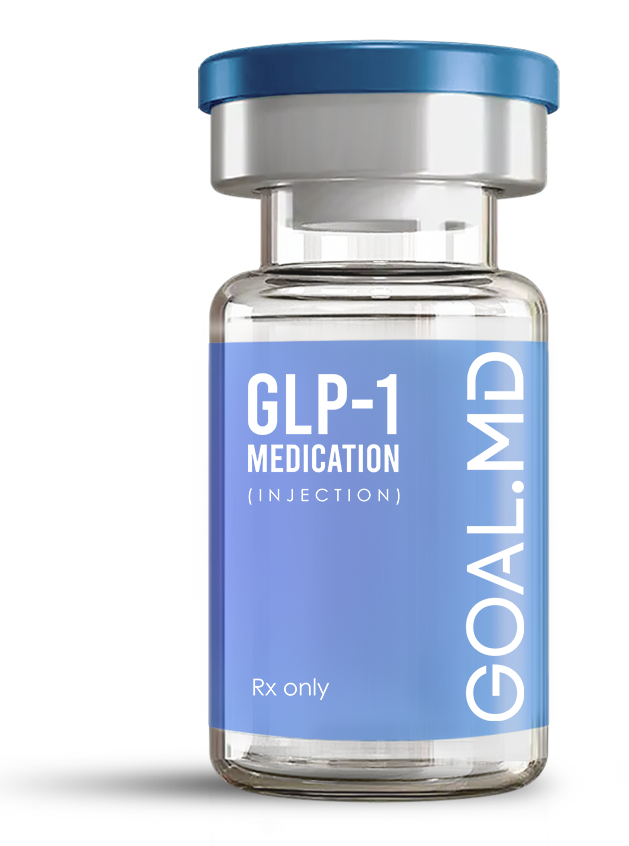
GOAL.MD Health & Wellness Blog
Evidence-based insights, medical weight loss information, and practical tips from our physicians and healthcare experts.

The Gut-Brain-GLP-1 Axis: Why Your Mood, Digestion, and Hunger Are All Connected
In recent years, science has begun unraveling one of the body’s most profound systems of communication—the gut-brain axis. And at the heart of this mind-body connection lies a powerful hormone you may not know by name, but likely know by effect: GLP-1.
You’ve heard of serotonin and dopamine. Now it’s time to get familiar with glucagon-like peptide-1, because understanding it could transform how we approach mental health, digestion, appetite, and even obesity.
What Is the Gut-Brain Axis, and Why Does It Matter?
The gut-brain axis is a bi-directional communication system between your gastrointestinal tract and your central nervous system. Your gut doesn’t just digest food—it talks to your brain, influencing how you feel, what you crave, and even how you think.
The gut is often called the “second brain” for a reason: it contains over 100 million neurons, produces 95% of the body’s serotonin, and plays a major role in emotional regulation, immune response, and appetite control.
Meet GLP-1: The Hormone That Bridges the Gap
GLP-1 is a naturally occurring hormone released from the gut when you eat. But it does far more than regulate blood sugar:
It slows down digestion, giving your brain time to register fullness
It suppresses appetite and reduces food cravings
It modulates insulin and glucagon, key hormones involved in energy balance
It sends signals to the brainstem and hypothalamus, regulating hunger and reward centers
It may even affect mood and neuroinflammation, according to emerging research
This is why GLP-1 receptor agonist medications (like semaglutide and tirzepatide) have become so much more than diabetes drugs—they’re becoming tools for whole-person metabolic health.
GLP-1 and the Mood Connection
Many people on GLP-1 medications report something surprising—a noticeable improvement in mental clarity, emotional stability, and reduced anxiety around food.
This isn’t just a placebo effect. New research is exploring how GLP-1 signaling may reduce neuroinflammation and modulate dopamine pathways tied to emotional regulation and addictive behaviors.
What we’re discovering is that treating metabolic dysfunction with GLP-1s doesn’t just help with weight or insulin—it may also relieve the mental fog, depression, and food obsession that so often accompany metabolic syndromes.
Hunger Isn’t Just in the Stomach—It’s in the Brain
The idea that hunger is a simple signal from an empty stomach is outdated. In truth, hunger is a complex interplay of hormonal, neurological, and psychological signals. Ghrelin (the hunger hormone), leptin (the satiety hormone), and GLP-1 all contribute to how full—or obsessed—you feel.
When GLP-1 receptor agonists are introduced, the feedback loop changes:
You feel satisfied sooner
Cravings don’t dominate your thoughts
Your emotional response to food cues weakens
Binge or compulsive eating tendencies often reduce dramatically
This is why patients often describe GLP-1 therapy as “peaceful” or “quiet”—because for the first time, their brain isn’t fighting their body.
The Vagus Nerve: The Superhighway Connecting Gut and Brain
A key part of the gut-brain-GLP-1 axis is the vagus nerve—a bundle of fibers that carries information between your gut and your brainstem. When GLP-1 is released in the gut, it activates receptors on the vagus nerve, sending a cascade of signals directly to brain centers involved in mood, motivation, and satiety.
This explains why GLP-1 therapy can alter your relationship with food, not just suppress your appetite. It’s not about willpower. It’s about rewiring communication across your entire metabolic-brain circuit.
Digestive Health: The Unsung Hero of Mental Wellness
GLP-1 also plays a role in gut motility, regulating how quickly food moves through your digestive system. This slower gastric emptying contributes to the feeling of satiety, but it also has other downstream effects:
Stabilized blood sugar = fewer mood swings
Balanced gut microbiome = better immune and mental function
Less bloating and better digestion = more energy and clarity
When you treat digestion as part of mental health, things start to click. And GLP-1s do exactly that—they create a synchronized rhythm between what you eat, how your body processes it, and how your brain responds.
Real People, Real Transformation
“I used to obsess over food constantly. After starting GLP-1 therapy, the noise just stopped. I could finally think clearly.”
— Melissa, 42, former binge eater
“I didn’t expect it to help my anxiety, but it did. I sleep better. I feel calmer. I don’t crash after meals.”
— Dev, 35, diagnosed with insulin resistance
These stories echo a truth science is beginning to confirm: healing metabolism can heal the mind.
The Future of Metabolic Psychiatry
As more research emerges, GLP-1s are being studied not just for weight loss and diabetes, but for addiction, Alzheimer’s, anxiety, and depression. Why? Because metabolic health is brain health.
We’re no longer talking about isolated systems. The gut, the brain, and the hormones that connect them are part of a single ecosystem. GLP-1s are giving us the tools to treat it holistically.
Take Control of Your Axis with GOAL.MD
At GOAL.MD, we don’t just offer GLP-1 therapy—we offer gut-brain restoration. Our care protocols are designed to improve mood, digestion, cravings, and energy from the inside out.
💉 GLP-1 prescriptions (Semaglutide, Tirzepatide)
🌿 Metabolism-friendly nutrition guidance
🧠 Mental health support tools
🧬 Lab monitoring and symptom tracking
Final Thoughts: You’re Not Broken—You’re Misaligned
If you’ve felt like your mood, digestion, and cravings are all out of sync, it’s not your fault. The modern world throws your gut-brain axis into chaos.
But with the right tools, your body knows how to heal. GLP-1s don’t just silence symptoms—they restore harmony. And when your gut, brain, and metabolism are in sync, you become unstoppable.
Why GOAL.MD?
✅ Sourced from audited 503a US compounding pharmacies.
✅ Custom dosages adjusted to your needs.
✅ Free consultation + 24/7 support.

How It Works
1. Quiz
90 seconds. No commitment.
2. Consult
Video chat with your GOAL.MD doctor.
3. Deliver
Meds at your door tomorrow.
Transform Your Life with Physician-Directed Care
Join thousands who've found success with physician-directed care. Take our 3-minute quiz to see if medical weight loss is right for you.








